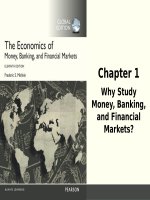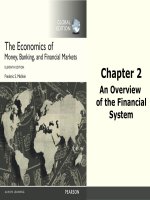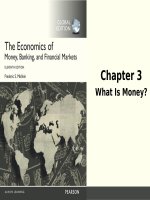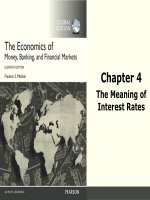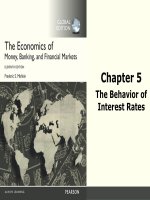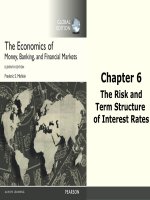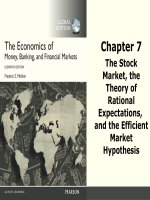The economics of money banking and financial markets 9th edition frederic s mishkin
Bạn đang xem bản rút gọn của tài liệu. Xem và tải ngay bản đầy đủ của tài liệu tại đây (20.73 MB, 705 trang )
THE ECONOMICS OF
MONEY,
BANKING
&FINANCIAL
MARKETS
The Addison-Wesley Series in Economics
Abel!Bernanke/Croushore
Maovewnumics*
Holt
Perlof£
Marhets, Games and Strate�ic Behavior
Bade/Parkin
Hubbard
Microeconomics: Theory and Applications
with Calculus
Foundations uf Economics*
Mont)', the Financial S:ystem, and tl1e Economy
Bierman/Fernandez
Game Thcmy lvith Ecmwrnit Applications
Hughes/Caiu
Amn-kan Ewnomk Histmy
Husted!Melvin
Binger/Hoffman
Mkroccmwmics wirh Calm! us
I11ternatio11al Ecmwmics
Boyer
Jehle!Reny
P1indplcs of Transportation Ewnomks
Advanccct Microcwnomk TIIeOf)'
Branson
Maovno!Wmic Theory and Puli�y
johnson-lans
A Health Economics Primer
Bruce
Klein
Puhlk Finance and the American Economy
Mathematical Mf.thods
.for Economics
Byrns/Stone
Ec01wmics
Krugman/Obstfeld
f11tcnwtiunal Economics: Theoty (.or Pulic_y·'"
Carlton!Perloff
Modern Industrial Organization
Laidler
Perman/Common/McGilvray/Ma
Nat.ural Resources and Environmental
Ewnomb
Phelps
Hwlth Ewnumics
Riddell!Shackelford!Stamos/
Schneider
Ewnomks: A Tool for Crirkallv
�
.
Unde-rscanding Socict_v
Ritter/Silber!Udell
Principles of MmtlJ� Banhing E.-r Financial
Marhds*
Rohlf
Introduction to Econmnic Reasoni11g
Ruffin/Gregory
Principles of Economics
Caves/Frankel/Jones
\Hn-!d Trade and Pavrnents: A.nlmrodw.:tirm
The Demand fur Mom�)'
Sargent
leeds/von Allmen
Rational Expectations
and 11IJ1mion
Chapman
Environmental Economics: Theory,
.
Applicatirm, and Policy
Leeds/von Allmen/Schimiug
Eco11mnics''
Cooler/Ulen
Law & Economics
lipsey!Ragan/Storer
Eco1wmics''
Sherman
Marhct Rc�rulation
Downs
An Economic ThcUI)' of' Dcmocra�y
Melvin
International Monf)' and Financf
Stock/Watson
Introduction to Ecmwmctrics
Ehrenberg/Smith
Modern Lalmr· Ecmwmics
Miller
Eomomics Today.;.
EkelundJResslerfTollison
Ecunomics�
Miller
Unde1·standi11g Modem Economics
Stock/Watson
Introduction to Eomometrics,
Brief Edition
Fusfcld
Miller/Benjamin
The Age of the Economist
The Economics �fMacro Issues
Tietenberg
Miller/Benjamin/North
Environmental Economics
and Policy
The Economics �fSports
Gerber
l11tenwtional Economics
TIH: Economics �fPuhlic Issues
Ghiara
Learning Econ.omics
Mills/Hamilton
Urban Economics
Gordon
Macroeamomics
Mishkin
The Ecmwmic.s l?f Mmtl_% Banhing, and
Financial Mar/lets*
Gregory
Essentials of Eumomks
Mishhiu
The Ecmwmb of Money, Banhing, and
Financial Marhcts, Business School Edition'
Gregory/Stuart
Ru.�sian and Soviet Economic Pcrfornuma
and Structure
Murray
Econometrics: A Modern Introduction
Hartwick!Olewiler
Tl1c Eamomks 1?{ Natuml Resourcr Usc
Parkin
Economic.�"
Hoffman/Averett
\H)Int'n and the Economy: Familv, \H)rk,
.
.
and PaJ'
*denotes
liimiiD
Perloff
Miuocumomb*
titles
Scherer
lndusl1y Smwurc, Srraregy,
and PuiJiic Poli�V
Studenmund
ll.'iing Eomomrt1ics: A. haaical Guide
Tietenberg/Lewis
Environmental and Natural Rcsoura
Economics
Todaro/Smith
Economic Development
\Valdman
Microewnomics
Waldman/jensen
lndust1ial Otganizatton: Them)'
and Practice
Wei!
Economic Growtl1
"Williamson
MacroeCOIWinics
Log onto www.myeconlab.com to learn more
Money,
Banl{ing
& Financial
Markets
THE ECONOMICS OF
NINTH EDITION
Frederic S. Mishkin
Col umbia University
Boston
London
Mexico City
Toronto
Munich
Addison-Wesley
San Francisco
Sydney
Paris
:--Jew York
Tokyo
Cape Town
Singapore
Madrid
Hong Kong
Montreal
Editor in Chief: Donna Battista
Acquisitions Editor: Noel Kamm Seibert
Pro] ect Manager: Kerri McQueen
Managing Editor: Nancy H. Fenton
Senior Production Supervisor: Kathryn Dinovo
Supplements Production Coordinator: Alison Eusden
Director of Media: Susan Schoenberg
Senior Media Producer: Melissa Honig
Coment Leads,MyEconlab: Douglas A. Ruby and Noel Lotz
Senior Author Suppon!Iechnology Specialist: j oe Vetere
Marketing Manager: Elizabeth A. Averbeck
Permissions Project Manager: Shannon Barbe
Permissions Project Supervisor: Michael j oyce
Senior Manufacturing Buyer: Carol Melville
Senior Media Buyer: Ginny Michaud
Cover Designer: Barbara Atkinson
Production Coordination,Text Design,Illustrations,and Composition: Thompson Steele
Composition: Nesbitt Graphics,Inc.
Cover images,clock w ise from top,right:
© Corbis; Superstock; Superstock; iStock
For permission to use copyrighted material, grateful acknow ledgment is made to the copyright holders
on p. C-1 , which are hereby part of this copyright page.
Cop)Tight © 20 1 0 ,20 0 7,20 0 4 Pearson Education,Inc. Al l rights reserved. No part of this publication may be
reproduced,stored in a retrieval system,or transmitted,in any form or by any means,electronic,mechanical,
photocopying, recording,or otherwise, without the prior w ritten permission of the publisher. Printed in the U nited
States of America. For information on obtaining permission for use of material in this w ork,please submit a w ritten
request to Pearson Education,Inc.,Rights and Contracts Department,50 1 Boylston Street,Suite 90 0 ,Boston,MA
0 21 1 6 ,fax y our request to 6 1 7-6 71 -3447, or e-mail at http: //w w w .pearsoned.com/legaVpermissions.htm.
Many of the designations used by manufacturers and sellers to distinguish their products are claimed as
trademarks. Where those designations appear in this book, and Addison-Wesley w as aware of a trademark claim,
the designations have been printed in initial caps or all caps.
Library of Congress Cataloging-in-Publication Data
Mishkin,Frederic S.
The economics of money, banking,and financial markets I Frederic
Mishkin. -- 9th ed. (and the 2nd ed. of the business ed.)
p. em. -- (The Addison-Wesley Series in economics)
Includes bibliographical references and index.
ISBN-1 3: 978-0-321 -59979-7 (main edition· alk paper)
ISBN-1 0 : 0 -321 -59979-9 (main edition. alk. paper)
ISBN-1 3: 978-0-321 -59988-9 (business edition. alk. paper)
ISBN-1 0 : 0 -321 -59988-8 (business edition : alk. paper)
l. Finance. 2. Money. 3. Banks and banking. I. Title.
HGl73.M6 32 20 1 0
332--dc22
20 0 90 1 86 32
1 2 3 4 5 6 7 8 9 1 0 --- CRK-1 3 1 2 1 1 1 0 0 9
Addison Wesley
is an imprint of
PEARSON
ISBCl-1 0 0 -3 21 -5 9 9 79 -9
www.pearsonhighered.com
ISBCl- 1 3 9 78 -0 -3 21 -5 9 9 79 -7
To Sally
BRIEF CONTENTS
PART 1
Introduction
1
Why Study Money,Banking, and Financial Marketsl
.. 3
An Overview of the Financial System .
What Is Money ?
PART 2
Financial Markets
. 25
........ 53
67
4 U nderstanding Interest Rates
. 69
The Behavior of Interest Rates
... 91
6 The Risk and Term Structure of Interest Rates ........................ 1 23
The Stock Market, the Theory of Rational Expectations,
and the Efficient Market Hypothesis .....................
PART 3
Financial Institutions
.... 1 47
167
An Economic Analysis of Financial Structure
... 1 6 9
financial Crises and the Subprime Meltdown
... 1 99
10 Banking and the Management of Financial Institutions .
11 Economic Analysis of Financial Regulation .
225
. ...... 255
281
12 Banking Industry : Structure and Competition .
PART 4
Central Banking and the Conduct
of Monetary Policy 313
13 Central Banks and the Federal Reserve System
31 5
14 The Money Supply Process.....................
.... 345
16 The Conduct of Monetary Policy: Strategy and Tactics
395
15 The Tools of Monetary Policy .
PART 5
International Finance and Monetary Policy
... 373
431
17 The Foreign Exchange Market .................................... 433
18 The International Financial System
PART 6
Monetary Theory
19 The Demand for Money
46 3
497
20 The ISLM Model
21 Monetary and Fiscal Policy in the ISLM Model
22 Aggregate Demand and Supply Analysis
23 Transmission Mechanisms of Monetary Policy: The Evidence .
.... 499
51 9
543
... 56 5
... 587
24 Money and ln!lation
617
25 Rational Expectations: Implications for Policy .
6 43
vii
I
:
CONTENTS
PART l
l
Introd uction
CHAPTER I
Why Study Money, Banking, and Financial Markets?
3
W hy Study Financial Marketsl ... . ...................................... 3
The Bond 1-larket and !merest Rates .
The Srock Marker
W hy Study Financial Institutions and Banking'
....... 5
St.rucmrc of rhe Financial System
Financial Crises
Banks and Other Financial Institutions
Financial lnnovar.ion
W hy Study :v!oney and Monetary Policyl
t-,,toncy and Business Cycles
Money and Inflation
10
1,toncy and Imeresr Rates
Conduct of Monetary Policy
. 10
Fiscal Policy and Monetary Policy
.... 12
W hy Study International Finance'
13
The Foreign Exchange Marker
13
14
The International Financial System
14
How We Will Study :v!oney, Banking, and Financial Markets
15
Exploring the Wr·b
CollecLing and Graphing Data
15
Web Exercises
... 16
Concluding Remarks
Summary 18
•
........... 17
Key Terms
Web Exercises 20
•
19
•
Questions and Problems 19
•
Web References 20
APPENDIX TO CHAPTER I
Defining Aggregate Output, Income, the Price Level,
and the Inflation Rate 21
Aggregate Output and Income
........ 21
Real Versus Nominal Magnitudes
....... 21
Aggregate Price Level
... 22
Growth Rates and the Inllation Rate
23
CHAPTER 2
An Overview of the Financial System
25
Function of Financial Nlarkets
....... 25
Structure of Financial Nlarkets
....... 27
ix
CO NTE NTS
Debt and Equity Markets
27
Primary and Secondary ivlarkers .
28
Exchanges and Over-the-Counter Markets
29
29
Money and Capital Markers
....... 30
Financial Market Instruments
.... 30
t-.·toncy Marker. Instruments
Following the Financial News
Money Market Rates
Following the Financial News
Capital Market Interest Rates
31
Capital t-.-tarkc:.·t Instruments
33
34
Internationalization of Financial Markets
Global
...... 36
Are U.S Capital Markets Losing Their Edgel
36
lntcrnar.ional Bond Market, Eurobonds, and Eurocurrencies
..... 37
37
World Srock Markers
Following the Financial News
Foreign Stock Market Indexes
38
Function of Financial Intermediaries: Indirect Finance
....... 39
Transaction Costs
Global
39
The Importance of Financial Intermediaries Relative to Securities Markets:
An International Comparison
40
Risk Sharing
40
Asymmclric Information: Adverse Sc1ection and T\.foral Hazard
41
Types of Financial Intermediaries ........................
Depository InsLilulions
43
Contracwal Savings Institutions
44
lnvcstmcnt. lnrcrmcdiaries
.. 45
Regulation of the Financial System
..... 46
Increasing InformationAvailable w lnvcsr.ors
..... 46
Ensuring the Soundness of Financial lmermcdlaries
47
Financial Regulation Abroad
Summary 49
•
Key Terms 50
\Veb Exercises 51
....... 42
•
49
•
Questions and Problems 51
•
\Veb References 52
CHAPTER 3
What Is Money?
53
Meaning of Money
Functions of Money
53
... 54
h,tcdium of Exchange
54
Unit of Accoum
55
Store of Value
Evolution of the Papnents System
Commodity Money .
56
57
. 57
Fiat Money
57
Checks
57
C 0 NTE NTS
Elcclronic Paymc:nl
SH
E-Moncy
58
FYI
Are We Headed for a Cashless Society'
59
Measuring Money
....... 6 0
. .
The Federal Reserve's !vionctary Aggrcgar.cs
Following the Financial News
FYI
The Monetary Aggregates
Where Are All the U.S. Dollars?
.
How Reliable Are the Money Data?
Summary 6 4
•
Web Exercises
PART2
xi
Key Terms 65
66
•
•
60
61
62
..................................... 6 3
Questions and Problems 65
•
Web References 6 6
Fi nanci al Markets
67
CHAPTER 4
Understanding Interest Rates
69
69
Measuring Interest Rates
. . . . . . . .
Pre.senL Value
Application Simple Present Value
69
.................... 7l
Application How Much is That j ackpot Worthl .
.
71
Four Types of Credit 1.farket Instruments
72
Yield to MaLUrity
72
Application Yield to Maturity on a Simple Loan
..... 73
Application Yield to Maturity and the Yearly Payment
on a fixed-Pay ment Loan .
....... 74
Application Yield to Maturity and the Bond Price for a Coupon Bond .
Application Perpetuity
Global
Negative T- Bill Rates l It Can Happen
. . . . . . . . .
79
The Distinction Between Interest Rates and Returns
HO
. . . . . .
MaLUrity and the Volatility of Bond ReLUrns: Interest-Rate Risk
FYI
Helping Investors to Select Desired Interest-Rate Risk
Summary
84
Application Calculating Real Interest Rates
With T I P S, Real Interest Rates Have Become Observable
in the United States
Summary 87
82
83
The Distinction Between Real and Nominal Interest Rates .
FYI
76
. 78
•
87
Key Terms
Web Exercises 8 8
•
87
•
Questions and Problems 8 8
Web References 8 9
....... 8 4
. 85
xii
C 0 NTE NTS
CHAPTER 5
The Behavior of Interest Rates
91
Determinants of Asset Demand
....... 9 1
Wealth
92
.. 92
Expccr.cd Returns
Risk
...... 92
Liquidity
..... 93
Theory of Asset Demand
93
Supply and Demand in the Bond Market
...... 9 4
Demand Curve
94
Supply Curve
95
MarkeL Equilibrium
96
Supply and Demand Analysis
97
...... 97
Changes in Equilibrium Interest Rates
Shifts in the Demand for Bonds
97
10 1
Shifts in the Supply of Bonds
Application Changes in the Interest Rate Due to Expected Inflation:
The fisher Effect
10 3
Application Changes in the Interest Rate Due to a Business Cycle Expansion ... 10 4
Application Explaining Low Japanese Interest Rates
...................... 10 6
Application Reading the Wall Street}ottntal "Credit Markets" Column
Following the Financial News
The ''Credit Markets" Column
10 7
10 8
Supply and Demand in the Market for Money: The Liquidity Preference framework .10 9
Changes i n Equilibrium Interest Rates i n the Liquidity Preference framework
111
111
Shifts in the Demand for Money
Shifts i n the Supply o f Money
. Ill
Application Changes in the Equilibrium Interest Rate Due to Changes
in Income,the Price Level,or the Money Supply
112
Changes in Income:
1 13
Changes in rhc Price Level
1 13
Changes in tht· Money Supply
1 13
Application Money and Interest Rates
................................. 114
Docs a Higher Rate of Growth of the Money Supply Lower Inr.erest Rates?
Summary
119
•
Web Exercises
Key Terms
12 0
•
119
•
Questions and Problems
Web References
119
. 1 15
•
12 1
CHAPTER 6
The Risk and Term Structure of Interest Rates
123
Risk Structure of Interest Rates
Default Risk
Application The Subprime Collapse and the Baa-Treasury Spread
Liquidity
12 3
123
. 127
127
Income Tax C:onsiclerar.ions
128
Summary
129
CO NTE NTS
Application Effects of the Bush Tax Cut and Its Possible Repeal
xiii
13 0
on Bond Interest Rates
Term Structure of Interest Rates
..... 130
Following the Financial News
Yield Curves
131
Expectations Theory .
. 132
Segmented Markets Theory
...... 135
LiquidiLy Premium and Preferred HabiLat Theories
136
Evidence on Lhc: Term StrucLurc:
140
Summary
FYI
140
The Yield Curve as a Forecasting Tool for Infiation and the Business Cycle
Application Interpreting Yield Curves,1980 -20 0 9
Summary
142
•
Web Exercises
Key Terms
144
•
14 3
•
141
Questions and Problems
Web References
I 41
14 3
•
144
CHAPTER 7
The Stock Market, the Theory of Rational Expectations,
and the Efficient Market Hypothesis 147
Computing the Price of Common Stock
.. 147
The One-Period Valuation Model
....... 14H
149
The Generalized Dividend Valuation Model
149
The Gordon Growth Model
How the Market Sets Stock Prices
150
Application Monetary Policy and Stock Prices ........................... 151
Application The Subprime Financial Crisis and the Stock Market .
152
.. 152
The Theory of Rational Expectations
Formal Statement of the Theory
..... 154
Rationale Behind the Theory
154
155
Implications of rhe Theory
The Efficient Market Hypothesis: Rational Expectations in Financial Markets
155
Rationale Behind the Hypothesis
157
Stronger Version of the Efficient "t-.,farkct Hypothesis
158
Application Practical Guide to Investing in the Stock Market
158
How ValuableAre Published Reports by lnvestmemAdvisers?
... ISH
Should You Be Skeptical of Hot. Tips>
FYI
. 159
Should You Hire an Ape as Your Investment Ad,iser7
16 0
Do Stock Prices Always Rise VVhen There Is Good News?
160
EITicienl Markel Prescription for lhc Investor
160
Application What Do the Black Monday Crash of 1987 and the Tech Crash
of 20 0 0 Tell U s About Rational Expectations and Efficient Markets' ...... 16 1
Behavioral Finance
Summary
16 3
•
Web Exercises
....... 162
Key Terms
165
•
16 4
•
Questions and Problems
Web References
165
16 4
•
xiv
C 0 NTE NTS
PART 3
Fi nanci al Ins ti tutions
167
CHAPTER 8
An Economic Analysis of Financial Structure 169
Basic Facts about Financial Structure Throughout the World
... 16 9
.... 172
Transaction Costs
172
How Transaction Casu:; Inl1uc:nce Financial StrucLure
173
How Financial lmermediaries Reduce Transacrion Costs
Asymmetric Information: Adverse Selection and :Vloral Hazard
............... 17 4
The Lemons Problem: How Adverse Selection Influences Financial Structure
.... 17 4
Lemons in the SLOck and Bond Markets
Tools to Help Solve Adverse Selection Problems
FYI
The Enron Implosion
177
How Moral Hazard Affects the Choice Between Debt and Equity Contracts
Moral Hazard in Equity Contracts: The Principal-Agem Problem
180
Tools w Help Solve the Princlpal-Agcm Problem
18 1
1H3
How Moral Hazard Influences Financial Structure in Debt Markets
Tools to Help Solve Moral Hazard in Debt Contracts
183
Summary
. 185
Application Financial Development and Economic Growth
FYI
1HO
Should We Kill
All the
Lawyers>
..... 186
18 8
Application Is China a Counter-Example to the Importance
188
of Financial Development> .
Conflicts of Interest
..... 18 9
\VhaL Are Contlicrs of Interest and \Vhy Do \Ve Care?
. 190
Why Do Canllicts of Interest Arise>
. 190
192
What Has Been Dane to Remedy Canllicts of lnterestl
FYI
The Demise of Arthur Andersen
FYI
Credit-Rating Agencies and the Subprime Financial Crisis
FYI
Has Sarbanes-Oxley Led to a Decline in U.S. Capital :Vlarkets>
Summary
195
•
Web Exercises
Key Terms
197
•
19 6
192
•
Questions and Problems
Web References
19 3
195
19 6
•
19 7
CHAPTER 9
Financial Crises and the Subprime Meltdown 199
Factors Causing Financial Crises
...................................... 19 9
Asset Market Effects on Balance Sheets
200
Dcr.erioration in Financial Institutions' Balance Sheets
201
Banking Crisis
201
Increases i n UnccnainLy
201
Increases in Inr.crcsr. Rates
201
Government Fiscal Imbalances
202
XV
CO NTE NTS
Dynamics of Past U.S. Financial Crises
...... 20 2
Stage One: Initiation of Financial Crisis
202
Stage Two: Banking Crisis
205
Stage Three: Debt Deflation
206
Application The Mother of all Financial Crises: The Great Depression
The Subprime Financial Crisis of 20 0 7-20 0 8
... 20 6
....... 20 7
... 207
Financial Innovar.ions Emerge in r.hc "t-.·tortgagc tvtarkers
Housing Price Bubble Forms
20H
20H
Agency Problc:ms Arise
Information Problems Surface
209
Housing Price Bubble Bursts
209
Crisis Spreads Globally
209
Banks Balance Shws Deteriorate
2 10
High-Profile Firms Fail
...... 2 10
.... 2ll
Bailout Package Debar.ed
Recovery in Sight?
Global
211
The Treasury Asset Relief Plan and Government Bailouts
21 2
21 2
Dynamics of Financial Crises in Emerging Market Economies
Stage One: Initiation of Financial Crisis
2 12
Stage Two: Currency Crisis
...... 2 15
Sragc Three: Full-Fledged Financial Crisis
...... 2 16
Application Financial Crises in Mexico,1 994-1995; EastAsia,l997-1998;
21 7
and Argentina,20 0 1 -20 0 2
Global
The Perversion of the Financial Liberalization/Globalization Process
Summary
222
•
Web Exercise
Key Terms 222
223
•
•
Questions and Problems 223
21 9
•
Web References 224
CHAPTER 10
Banking and the Management of Financial Institutions 225
The Bank Balance Sheet ............................................. 225
LiabiliLics
225
Assets
228
Basic Banking
...... 229
General Principles of Bank Management
............
...... 23 2
Liyuidicy Management and the Role of Reserves
232
.'\.sseL Managc:menl
235
Liabilicy Management
236
Capital Adequacy 1.fanagemenr
237
Application Strategies for Managing Bank Capital
Application How a Capital Crunch Caused a Credit Crunch
in 20 0 8 ................. .
Managing Credit Risk
· · · · · · · ·
· · · · · · · · · · · · · · · · · ·
... 239
... 240
....... 241
Screening and 1.fonitoring
241
Long-Term Customer Relationships
242
xvi
CO NTE NTS
Loan Commitments
243
Collateral and Compensating Balances
243
Credit Rationing
244
Managing Interest- Rate Risk
2 45
Gap and Duration Analysis
Application
. 245
Strategies for Managing Interest-Rate Risk .
....... 2 47
2 47
Off- Balance- Sheet Activities
Loan Sales
247
Generation of Fcc Income
248
Trading Activities and Risk i'vlanagcmcm Techniques
248
Global Barings, Daiwa, Sumitomo, and Societe Generate: Rogue Traders
and the Principal-Agent Problem
Summary 250
•
Key Terms 2 5 1
Web Exercises 252
•
•
249
Questions and Problems 2 5 1
•
Web References 253
CHAPTER I I
Economic Analysis of Financial Regulation 255
Asymmetric Information and Financial Regulation
2 55
Government Safety Net
255
Global The Spread of Government Deposit Insurance Throughout the World:
Is This a Good Thingl
257
Restrictions on Asset Holdings
260
Capital Requirements
260
261
Prompt Corrcclivc Action
Global Basel 2 How Well Will It Work?
2 62
Financial Supervision: Charlcring anJ Examination
263
Assessment of Risk Management
.... 264
Disclosure Requirements
...... 265
Consumer Protection
FYI
266
Mark-to-:v!arket Accounting and the Subprime Financial Crisis
266
Restrictions o n Competition
267
Summary
267
FYI
The Subprime Mortgage Crisis and Consumer Protection Regulation
Global International Financial Regulation
268
269
The 19 8 0s Sa\ings and Loan and Banking Crisis
Banking Crises Throughout the World
"Deja vu All Over Again"
Whither Financial Regulation After the Subprime Financial Crisis?
..... 2 7 1
...... 2 7 3
273
..... 2 7 5
Increased Regulation of 1viongage Brokers
. -.... 276
Fewer Subprime tv1ortgage Products
...... 276
Regulation Compensation
276
Higher Capital Requirements
276
CO NTE NTS
xvii
Additional RcgulaLion of Privately Owned Govc:rnmem-Sponsored Enterprises
277
Heightened Regulation to Limit Financial Institutions' Risk Taking
2 77
Increased Regulation of Credit-Rating Agencies
277
Additional Regulation of Derivatives
277
The Danger of Overregulation
Summary 2 78
•
Key Terms 2 78
•
Web Exercises 2 79
278
Questions and Problems 2 78
•
Web References 2 7 9
CHAPTER 12
Banking Industry: Structure and Competition 281
Historical Development of the Banking System
2 Hl
-r..,tultiplc Regulatory Agencies
283
Financial Innovation and the Growth of The "Shadow Banking System"
2 H4
Responses ro Changes in Demand Conditions: lnr.crcsr.-Rar.c Volatility
..... 285
ResponS('S w Changes in Supply Conclir.ions: Information Technology
. 286
FYI
Will "Clicks" Dominate "Bricks" in the Banking Industry)
FYI
Bruce Bent and the :Vloney :vlarket :vlutual Fund Panic of 2 0 0 8
2 HH
Avoidance: of ExisLing Regulations
289
291
Financial Innovation and the Decline of Traditional Banking
Structure of the U.S. Commercial Banking Industry
296
Restrictions on Branching
297
Response lo Branching Restrictions
Bank Consolidation and ;\!ationwide Banking
292
.... 2 9 5
............................ 2 9 8
The Ricglc-Neal lnterstate Banking and Branching Efficiency Act of 1994
300
\Vhat \Vill rhe Structure of the U.S. Banking Industry Look Like
. 300
in rhc Fmure?
Global Comparison of Banking Structure in the United States
and Abroad
30 1
Arc Bank Consolidation and Nationwide Banking Good Things?
Separation of the Banking and Other Financial Ser\ice Industries .
Erosion of Glass-Sreaga11
30 1
...... 302
302
The Gramm-Leach-Bliley Financial Services ModernizationAct of 1999:
Repeal of Glass-Steagall
Implications for Financial Consolidation
303
303
Separation of Banking and Or.her Financial Services Industries Throughout
che World
FYI
...... 303
The Subprime Financial Crisis and the Demise of Large, Free- Standing
Investment Banks
30 4
Thrift Industry: Regulation and Strucwre
Savings and Loan Associations
tvtutual Savings Banks
Credit Unions
Imernational Banking
Eurodollar Market
30 4
304
.... 305
...... 305
...... 30 6
306
xviii
C 0 NTE NTS
Global Ironic Birth of the Eurodollar Market
307
Structure of U.S. Banking Overseas
307
Foreign Banks in the United States .
•
Summary 30 9
Web Exercises 311
PART 4
30H
Key Tenns 310
•
Questions and Problems 310
Web References 311
Central Banking and the
Cond uct of Monetary Policy
3 13
CHAPTER 13
Central Banks and the Federal Reserve System 315
The Price Stability Goal and the :-.lominal Anchor
........... 315
The Role of a Naminal Anchor
3 16
The Time- lnconsisu::ncy Problem
3 16
Other Goals of Monetary Policy
317
High Employment
3 17
Economic Growth
3 18
Stability of Financial t.farkets
3 18
Interest-Rate Stability
3 1H
Stability in Foreign Exchange Markets
....... 3 19
Should Price Stability Be the Primary Goal of :Vlonetary Policy?
...... 319
3 19
Hierarchical Versus Dual11andatcs
Price Stability as the Primary, long-Run Goal of MonNary Policy
Origins of the Federal Reserve System
Inside the Fed
320
.................................. 32 0
The Political Genius of the Founders of the Federal Reserve System
Structure of the Federal Reserve System
322
Federal Reserve Banks
Inside the Fed
...... 323
The Special Role of the Federal Reserve Bank of New York
Member Banks
The Role of the Research Staff
326
32 7
32H
Federal Open Markel Commiuee (FOMC)
The FOMC Meeting
Inside the Fed
..... 32H
Green, Blue, and Beige: W hat Do These Colors
Mean at the Fed?
32 9
Why the Chairman of the Board of Governors Really Runs the Show
330
How Independent is the Fedl
Inside the Fed
32 4
325
Board of Governors of the Federal Reserve System
Inside the Fed
32 1
How Bernanke's Style Differs from Greenspan's
Structure and Independence of the European Central Bank
330
331
....... 333
Differences Between the European System of Cemral Banks and
the Federal Reserve System
333
C 0 NTE NTS
Governing Council
334
How Indcpenclent Is the ECB'
335
Structure and Independence of Other Foreign Central Banks
335
Bank of Canada
335
. 336
Bank of England
.... 336
Bank of japan
337
The Trend Toward Greater Independence
Explaining Central Bank Behavior
Inside the Fed
xix
..................................... 337
The Evolution of the Fed's Communication Strategy
338
339
Should the Fed Be Independent/
The Case for Independence
339
The Case Against Independence
340
Central Bank Independence and Macroeconomic Performance Throughout the World .. 34 1
Summary 34 1
•
Key Terms 342
Web Exercises 34 3
•
•
Questions and Problems 342
Web References 34 3
CHAPTER 14
The Money Supply Process
345
Three Players in the Money Supply Process
The Fed:S Balance Sheet
Liabilities
i\ssCls
Control of the :vlonetary Base
Federal Reserve Open Market Operations
..... 345
....... 345
...... 346
347
347
348
Shifts from Deposits into Currency
35 1
Discount Loans
352
Other Factors That Affect the Monetary Base
Overview of the Feel's Ability to Comrol the Monetary Base
Multiple Deposit Creation: A Simple Model ...............
.... 353
....... 353
..... 354
Deposit. Crcarion: The Single Bank
354
Deposit Creation: The Banking System
355
Deriving the Formula for T\.fultiplc Deposit Creation
35H
Critique of the Simple Model
Factors that Determine the Money Supply
Changes in t.he Nonborrowed Monetary Base, MB�
Changes in Borrowed Resenrcs, BR, from the Feel
359
36 0
...... 360
...... 360
Changes in Lhe Required Reserve Ralio, r
360
Changes in Currency Holdings
36 1
Changes in Excess Reserves
36 1
Overview of the Money Supply Process
36 1
The Money :v!ultiplier
362
Deriving the Money Multiplier
Inlllition Behind the Money Multiplier
Money Supply Response ro Changes in the Factors
Application The Great Depression Bank Panics,193 0 -193 3
362
...... 364
. 365
. 366
XX
C 0 NTE NTS
Summary 36 9
•
Key Terms 370
Web Exercises 371
•
•
Questions and Problems 370
•
Web References 372
CHAPTER 15
Tools of Monetary Policy
373
The Market for Reserves and the Federal Funds Rate
....... 37 3
Demand and Supply in the Market for Reserves
Inside the Fed
...... 373
W hy Does the Fed Need to Pay Interest on Reserves/
375
How Changes in the Tools of Monetary Policy Allect the Federal Funds Rate
Application How the Federal Reserve's Operating Procednres
Limit Flnctuations in the Federal Funds Rate ..............
Open Market Operations
376
...... 3 80
....... 38 1
A Day at the Trading Desk
...... 38 1
Advantages of Open Market Operations
Discount Policy
383
............................
..... 38 4
Operation of the Discount \Vindow
384
Lender of Last Resort
384
Inside the Fed
Inside the Fed
Using Discount Policy to Prevent a Financial Panic
38 6
Federal Reserve Lender-of- Last- Resort Facilities During
the Subprime Financial Crisis
3H7
Advantages and Disadvantages of Discount Policy
388
Reserve Requirements
3H9
Disadvantages of Reserve Requiremcnt:s as a Policy Tool
389
Monetary Policy Tools of the European Central Bank
..... 39 0
Open Market Operations
...... 390
Lending to Banks
....... 390
Reserve Rcq uiremcnts
Summary 39 I
•
39 1
Key Terms 39 1
Web Exercises 392
•
Questions and Problems 392
Web References 39 3
CHAPTER 16
The Conduct of Monetary Policy: Strategy and Tactics
Monetary Targeting
..... 395
Monetary Targering in rhe Unired Stares, japan, and Germany
Global The European Central Bank's Monetary Policy Strategy
... 395
39 8
Advantages of 1-lonetary Targeting
Disadvantages of "tvlonetary Targeting
Inflation Targeting
Inflation Targcr.ing in New Zealand, Canada, and the United Kingdom
Advantages of Innar.ion Targeting
Disadvamagcs of Inflation Targeting
Monetary Policy With an Implicit :-Jominal Anchor
395
399
399
39 9
... 400
...... 402
403
..... 4 0 5

